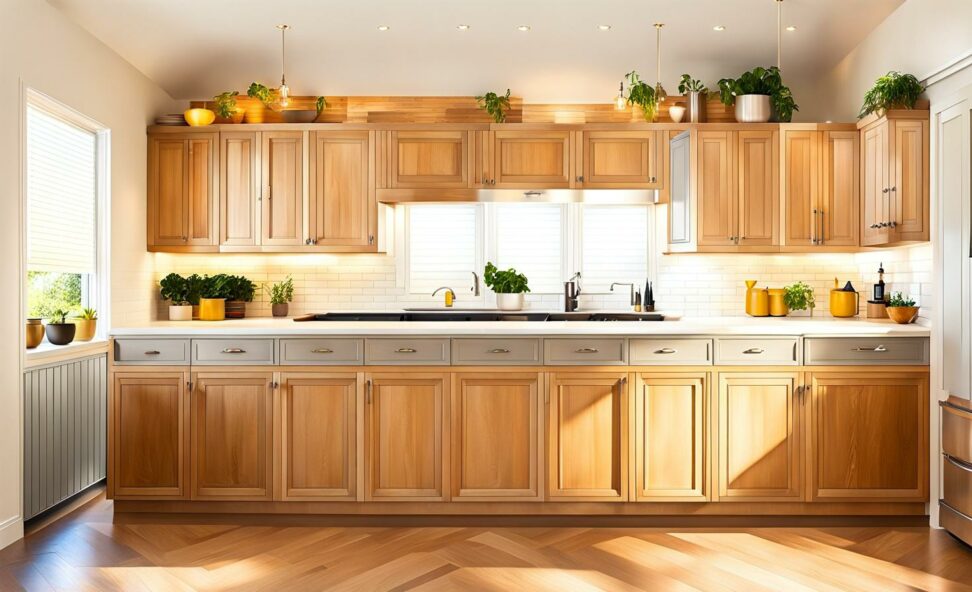The Complete Pros and Cons Guide to Birch Kitchen Cabinets
With sleek lines and light natural wood grains, birch cabinets can infuse style and warmth into any kitchen. But is birch the right choice for your remodeling plans? Like all materials, birch has advantages and disadvantages to weigh.
We’ll uncover birch’s standout benefits along with the potential downsides to consider. Read on for the complete facts so you can decide if birch is a fit for your next kitchen revamp.
An Overview of Birch Wood for Cabinets
Birch is a popular North American hardwood used in furniture, flooring, and cabinetry. It has a straight, fine grain pattern that varies from moderate to very pronounced. Birch naturally exhibits a pale yellowish-white color. The wood’s slight reddish-brown undertones become more prominent with age.
Thanks to birch’s strength, workability, and finishing qualities, it’s a woodworker’s favorite. Birch takes stains and paints beautifully while resisting warping. It has sufficient hardness to withstand daily use but costs less than traditional cabinet woods like maple, oak, and cherry.

Key Properties of Birch Wood
- Pale yellowish-white color with slightly reddish-brown undertones
- Distinct, often bold grain patterns
- Density provides good durability
- Machines and finishes well
How Birch Compares to Other Cabinet Woods
Birch offers greater affordability than most other hardwoods used for cabinetry. Its durability falls just short of premium options like maple and cherry. Birch also lacks the moisture resistance of maple or hickory.
On the plus side, birch takes an exceptional array of stains and painted finishes. Its smooth texture also hides glue joints very effectively. With the right care and maintenance, birch cabinets provide an attractive, budget-friendly choice.
The Pros of Choosing Birch Cabinets
From a graceful, soothing look to easy maintenance, birch cabinets have a lot going for them. Here are some of the top benefits.
Striking Natural Wood Grain
Birch shows off captivating, varied grain patterns sure to add warmth and texture. The wood's innate beauty shines whether you opt to let the natural pale color emerge or use stains and paint.
Myriad Staining and Painting Options
One major perk of birch is its ability to transform through stains and paints. Deep walnut, cherry, and espresso stains look magnificent against birch’s dramatic grains. For a streamlined modern aesthetic, painted birch cabinets in white, gray, navy, or black exude sophistication.
Cost Savings Over Pricier Woods
For budget-focused renovators, birch kitchen cabinets offer big savings. At $60-120 installed per linear foot, birch costs significantly less than maple, oak, cherry, and exotic imported woods.
Durability for Years of Reliable Use
While not the most rugged wood available, birch holds up very well to the demands of a kitchen. Birch provides adequate hardness and density to resist scuffs, scratches, and dents under normal use.
Easy Maintenance Keeps Cabinets Looking Fresh
Simple regular cleaning is all that’s needed to keep birch cabinets looking like new. Birch doesn’t easily show grease, water spots, or dirt. Just use a soft cloth with mild soap and water to restore luster.
Potential Drawbacks of Birch Cabinets
Despite many advantages, birch also comes with a few disadvantages to factor in.
Susceptible to Moisture Damage
One downside of birch is its middling moisture resistance. Birch contains more moisture than woods like teak or mahogany. Exposure to excessive humidity or water can cause swelling, warping, and discoloration.
Prone to a Yellowed Tinge Over Time
Unfinished birch develops a yellowish patina as it ages. Some homeowners prefer this warm, mellowed look. But if you wish to maintain a light color, stains and finishes are needed to prevent yellowing.
Weaker Against Dents and Wear Than Ultra-Hardwoods
Although sufficiently hardy for most uses, birch falls short of the most durable cabinet wood options. It's slightly softer than long-lasting maple, hickory, and oak. Expect to see scratches, scuffs, and dents over a decade or two of heavy kitchen use.
Pale Native Color Lacks Richness on Its Own
If you want deep, dramatic wood tones in your kitchen, birch alone won’t fit the bill. Birch's light native color lacks the bold richness of woods like walnut, cherry, and mahogany. Stains and paints help compensate for the washed-out look.
Tips for Maximizing Birch Cabinets in Your Kitchen
To get the most satisfaction from your birch cabinets, keep these recommendations in mind:
- Use water-resistant finishes and construction adhesives to minimize moisture damage.
- Clean regularly with mild soap and soft cloth to maintain the wood’s integrity.
- Pick medium to dark stain shades to emphasize birch's striking grains.
- Opt for knobs, pulls, and handles in satin nickel or bronze to complement birch's warm tones.
With an attractive natural grain, birch offers a stylish kitchen look on a budget. Consider moisture protection, frequent cleaning, and rich stains or paints to keep your birch cabinets looking fabulous for years to come. Weighing the pros and cons carefully helps ensure birch is the best fit for your space and remodeling plans.